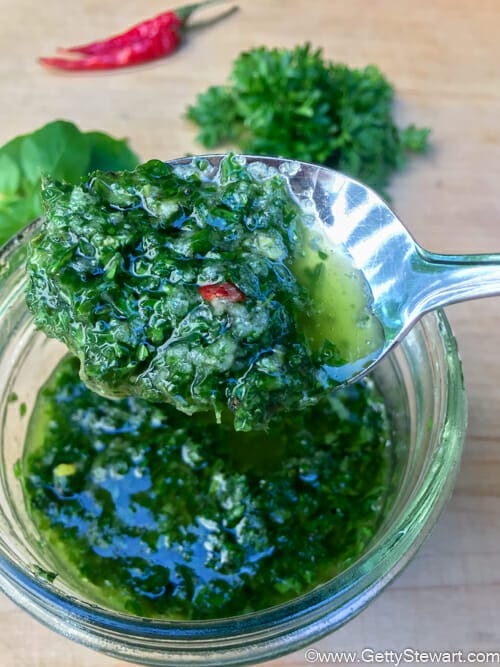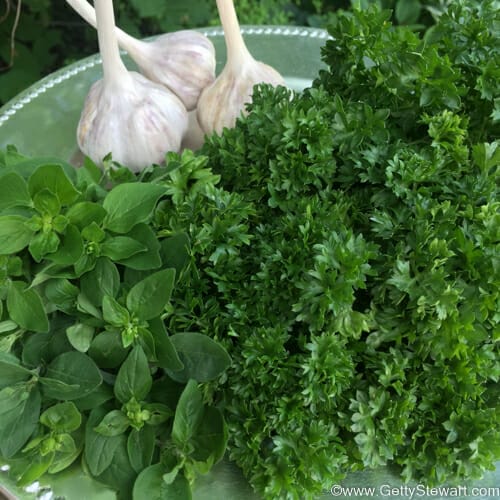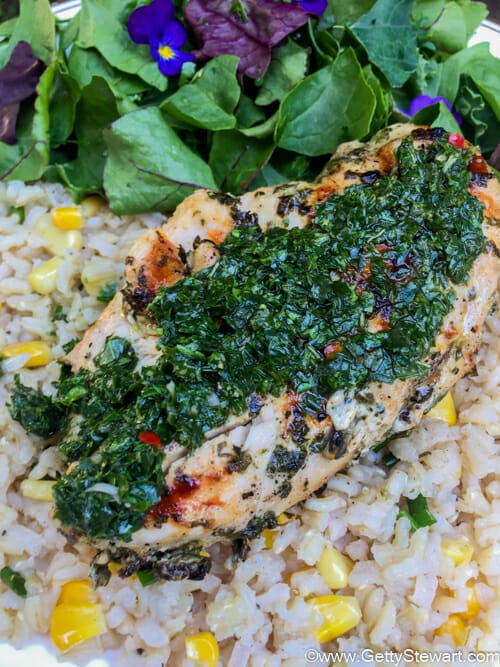How to Make Chimichurri – A Green Herb Sauce
Have you tried chimichurri sauce? It’s a green, fresh herb sauce made popular in South America where it is commonly used to top grilled beef. But like others before us, we’ve also enjoyed it on chicken, burgers, and fried rice pilaf.

I love that it’s easy to make and features fresh garden herbs. Seriously, I get super excited when I find a recipe that uses handfuls of fresh parsley right out of the garden. And fresh oregano? Really, how many recipes feature fresh oregano! Hello chimichurri.


Apparently, the traditional, and some suggest original, Argentinian recipe uses only garlic, parsley and oregano with oil and red wine vinegar, while other South American countries add cilantro and hot peppers. Who knows for sure, personally, I suspect the original cooks across South America used whatever fresh ingredients they had in abundance at any given time. Regardless of who uses what ingredient where, I think it’s safe to say – there’s lots of room for variations so go ahead and use whatever ingredients you have on hand and that you like.
I pieced together my chimichurri recipe based on my preferences – not too garlicky, not too acidic, plenty of parsley and enough red pepper to give it a zip but not make it over the top hot. I’ve made it with and without cilantro just to see what we prefer. Our preference is for adding cilantro, but if you don’t love cilantro, it’s still awesome without it.

Chimichurri Recipe
Chimichurri – A fresh green herb sauce
Ingredients
- 2 Tbsp red wine vinegar
- 2-4 cloves garlic cut in quarters
- 1 cup packed parsley leaves
- 3 Tbsp fresh oregano leaves
- 1/2 cup cilantro optional
- 1/4 tsp hot red pepper flakes more or less
- 1/2 tsp salt
- 1/2 cup canola oil
Instructions
- In a food processor, mix vinegar, garlic, parsley, oregano, cilantro, hot pepper flakes and salt. Pulse until herbs are chopped but not liquefied.
- Pour in oil and pulse briefly just until combined.
- Scrape into small dish.
- Cover and let rest for 30 minutes before serving over grilled steak, burgers or chicken.
- Store extras for up to 3 days in the refrigerator.
- Makes 3/4 cup
Notes
Chimichurri is best made with fresh herbs, do not substitute fresh parsley with dried. If necessary, 1 Tbsp of dried oregano can be used – allow to soak to ensure oregano fully re-hydrates.
Nutrition Facts (per serving)
What’s the Difference Between Pesto and Chimichurri?
Does the idea of mixing fresh garden herbs with oil seem vaguely familiar? Perhaps it reminds you of pesto – a fresh green sauce originating in Italy where fresh basil is mixed with oil, pine nuts and Parmesan cheese. While both chimichurri and pesto combine oil and fresh herbs and garlic, the taste and the additional ingredients are quite different.
Pesto: herbs, oil, garlic, nuts and cheese
Chimichurri: herbs, oil, garlic, vinegar
The acid in chimichurri makes it taste a little more zippy and also makes it a great marinade while pesto has a richer texture and flavor. They are different enough that they are not completely interchangeable. I mean sure, you could pesto on a steak and mix chimichurri with pasta, but you’d have a very different experience than if you followed the normal practice of pesto on pasta and chimi sauce on steak.
What the two sauces do have in common is endless variations. Think of all the different pesto versions you’ve seen – people will mix oil, garlic, nuts and Parmesan with just about anything! Likewise, people are mixing all sorts of chimichurri variations.
And why not?! Go with your gut and whatever ingredients you have on hand – explore, experiment, enjoy!
When you make a batch of chimichurri or pesto, let me know how it goes and show me! Take a photo, post it on Instagram and tag #getgettys so I can see it and like it!
Sign up to get articles by Getty delivered to your inbox. You’ll get recipes, practical tips and great food information like this. Getty is a Professional Home Economist, speaker and writer putting good food on tables and agendas. She is the author of Manitoba’s best-selling Prairie Fruit Cookbook, Founder of Fruit Share, a mom and veggie gardener.


